THANK YOU!
YOUR PURCHASE OF THESE BOOKS SUPPORTS THE WEB SITES THAT BRING TO YOU THE HISTORY BEHIND OLD AIRFIELD REGISTERS
Your copy of the Davis-Monthan Airfield Register 1925-1936 with all the pilots' signatures and helpful cross-references to pilots and their aircraft is available at the link. 375 pages with black & white photographs and extensive tables
---o0o---
The Congress of Ghosts (available as eBook) is an anniversary celebration for 2010. It is an historical biography, that celebrates the 5th year online of www.dmairfield.org and the 10th year of effort on the project dedicated to analyze and exhibit the history embodied in the Register of the Davis-Monthan Airfield, Tucson, AZ. This book includes over thirty people, aircraft and events that swirled through Tucson between 1925 and 1936. It includes across 277 pages previously unpublished photographs and texts, and facsimiles of personal letters, diaries and military orders. Order your copy at the link.
---o0o---
Military Aircraft of the Davis Monthan Register 1925-1936 is available at the link. This book describes and illustrates with black & white photographs the majority of military aircraft that landed at the Davis-Monthan Airfield between 1925 and 1936. The book includes biographies of some of the pilots who flew the aircraft to Tucson as well as extensive listings of all the pilots and airplanes. Use this FORM to order a copy signed by the author, while supplies last.
---o0o---
Art Goebel's Own Story by Art Goebel (edited by G.W. Hyatt) is written in language that expands for us his life as a Golden Age aviation entrepreneur, who used his aviation exploits to build a business around his passion. Available as a free download at the link.
---o0o---
Winners' Viewpoints: The Great 1927 Trans-Pacific Dole Race (available as eBook) is available at the link. This book describes and illustrates with black & white photographs the majority of military aircraft that landed at the Davis-Monthan Airfield between 1925 and 1936. The book includes biographies of some of the pilots who flew the aircraft to Tucson as well as extensive listings of all the pilots and airplanes. Use this FORM to order a copy signed by the author, while supplies last.
---o0o---
Clover Field: The first Century of Aviation in the Golden State (available in paperback) With the 100th anniversary in 2017 of the use of Clover Field as a place to land aircraft in Santa Monica, this book celebrates that use by exploring some of the people and aircraft that made the airport great. 281 pages, black & white photographs.
---o0o---
Thanks to Guest Editor Bob Woodling for help researching this page and for his liaison with Parkison's son, John, who shared photographs and other information.
SPONSORED LINKS
HELP KEEP THESE WEB SITES ONLINE
FOR YOUR CONVENIENCE
You may NOW donate via PAYPAL by clicking the "Donate" icon below and using your credit card. You may use your card or your PAYPAL account. You are not required to have a PAYPAL account to donate.
When your donation clears the PAYPAL system, a certified receipt from Delta Mike Airfield, Inc. will be emailed to you for your tax purposes.
---o0o---
AMHERST MAX PARKISON
Max Parkison landed once at Peterson Field, on May 30, 1937 (he didn't enter a date in the Register, but we have his pilot log book, below, that verifies the date). He flew the Stinson SR-8D (S/N 9721) he identified as NC16149, owned by the Oil Well Drilling Company. Based at Hobbs, NM, where the company had a base of operations, he carried two unidentified passengers.
Below, a photograph of Parkison (L) with the Stinson, standing by three unidentified gentleman. Upon magnification, the gentleman in sun glasses, second from left, seems to be dipping into a can of Prince Albert tobacco. It is not clear if any of the men are the unidentified passengers carried during Parkison's 1937 landing. Chances are a couple of them are. The lettering on the fuselage below the cockpit window says, "Oil Well Drilling Co. Dallas Texas."
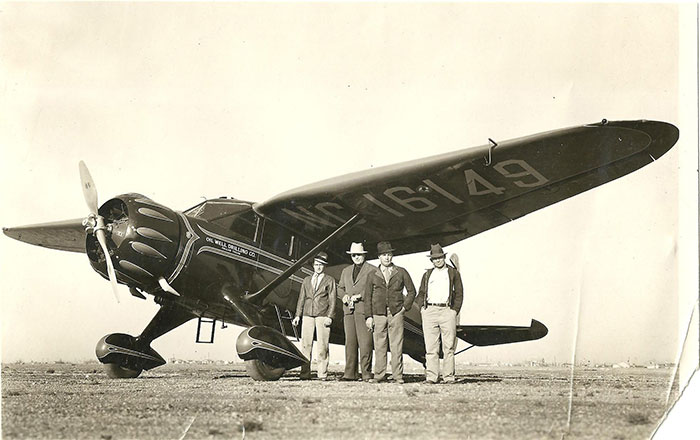 |
We know from his log book, below, that his flight departed Hobbs for Colorado Springs via Amarillo, TX. He departed Colorado Springs for the return to Hobbs on June 2nd with three passengers, stopping in Amarillo and Midland, TX. No reason for the flights was given.
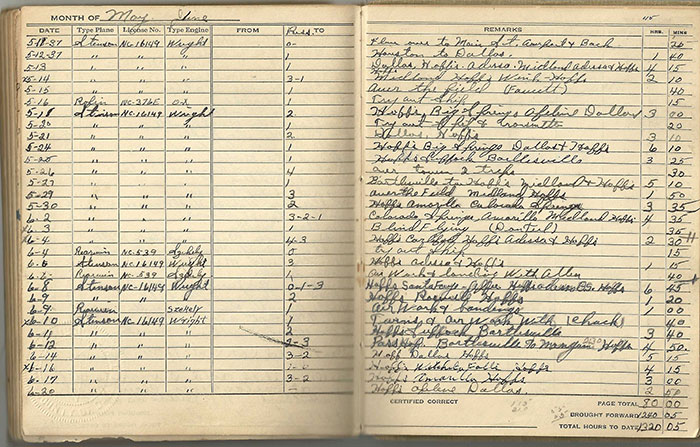 |
Born Amherst Henry Max Parkison on October 27, 1914 in Percival, IA, he was known as Max to everyone who knew him. Shortly after graduating from Percival High School, Max traveled to Texas to attend a flight school at Grand Prairie airport. There he quickly mastered flying and soloed on February 15, 1933, accumulating the grand total of 4.5 hours of flying instruction. Below, a photograph from that time period.
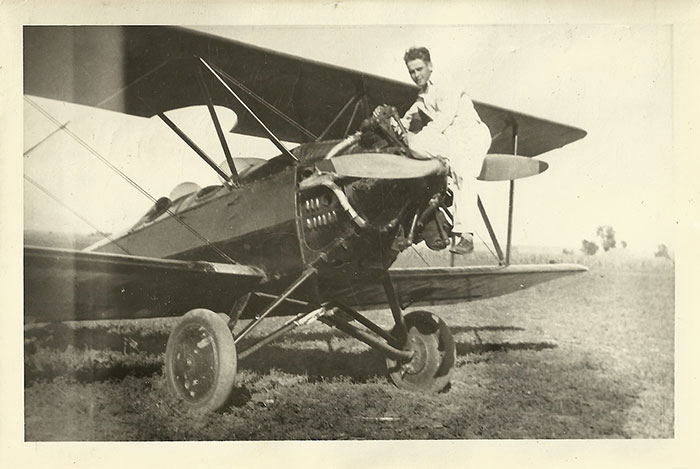 |
He subsequently accumulated enough flying hours to be hired in 1936 as chief pilot of Oil Well Drilling Co. The logbook page gives a good idea of the large amount of flying that Max accomplished and the busy schedule that he kept in flying all over the Southwest in the Stinson.
_Bee.jpg) |
Periodically there were times when flying for the company allowed him to show off his flying skills to his hometown Iowans as shown in the Jefferson (IA) Bee account of his buzzing of Percival, February 23, 1937, left. Another page of his logbook shows that the event occurred on New Years Day 1937.
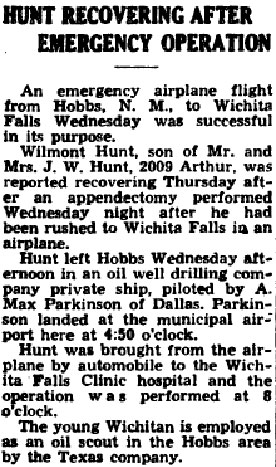 |
More serious non-business flying occurred on occasion, as evidenced by his medevac flight from Hobbs to Wichita Falls, TX with a sick company employee. The flight is shown on the 1937 log book page above on June 16, 1937. It was also documented in the Wichita Daily Times, June 17, 1937, right.
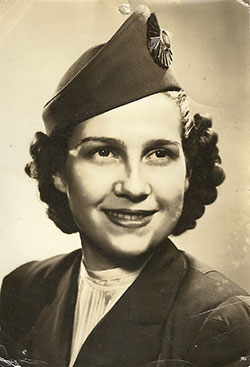 |
In February 1939 Max parlayed his flying experience by signing on with Transcontinental & Western Air as a first officer. The airline (later named TWA) flew the southern transcontinental route through the territory where Max had flown since 1936, no doubt giving Max a real advantage in qualifying for the job. Max quickly advanced to the left-hand seat, having been promoted to captain on August 15, 1940. Flying the line on April 1, 1941, he met TWA hostess Agnes Lorraine St. George, nicknamed “Tip,” left.
The couple married in Detroit on July 28, 1941 and later established a home in Kansas City, MO and raised two sons, Jim and John. Flying for TWA during the war, Max was assigned as a check pilot on March 22, 1943. TWA was at that time planning its post-war international routes and getting ready to introduce the iconic triple-tailed Lockheed Constellation into its growing fleet of airplanes.
The pages of his logbook dated February 1946, below, show several interesting entries. On February 1st, Max flew a Lockheed Constellation with fleet number 503 from Kansas City, MO to Burbank, CA and on to San Francisco. The Connie had departed New York City for Burbank at 6:42 A.M., stopping at Kansas City to board additional passengers, and flying on to Burbank with Parkison at the controls. The plane set an east-west transcontinental record of 10 hours 49 minutes on that flight. It then flew on to San Francisco on a promo flight with 45 passengers, at a cruise speed said to be 375 mph. His 7 hours and 15 minutes of flying time represented a very long day for Parkison.
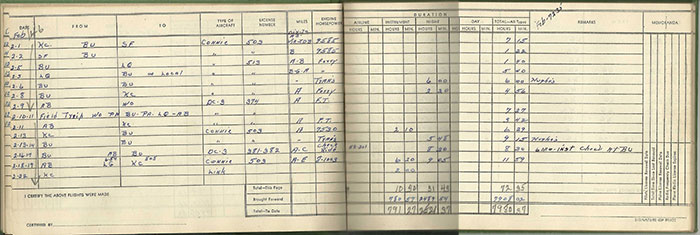 |
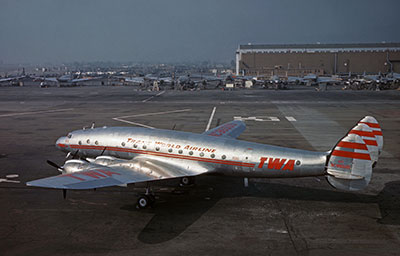 |
Max flew the Connie back to Burbank on February 2nd with 56 passengers (49 with a crew of 7) breaking a record for the most passengers carried between these two cities. Flight time was 1 hour 14 minutes with a cruise speed averaging 275 mph, and a maximum of 305 mph between Fresno and Bakersfield.
But here is the important historic part. After landing in Los Angeles the plane was immediately prepped for an early morning February 3rd VIP flight to New York. On that day, Connie 503 (NC86503) was used to inaugurate scheduled TWA domestic Constellation service, flying from Burbank to LaGuardia in 7.5 hours, with TWA President Jack Frye at the controls. You can read about this flight in TWA's employee newspaper, The Skyliner, for January-February, 1946 at the link (PDF 724Kb). Above, a photograph of a TWA Constellation on the ramp at Burbank, CA, 1946.
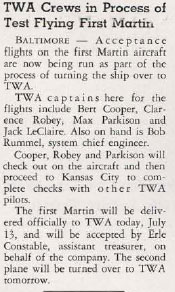 |
TWA’s owner, Howard Hughes, took great interest in the introduction of the Lockheed Constellation, which unfortunately was beset with a large number of teething problems during its first several months of service. Cabin pressurization and ventilation issues were problematic, so Hughes decided to work on solutions rather than wait for Lockheed to investigate the root causes. Max was assigned to fly some of the test flights while Hughes worked in the cabin. The assignment entailed “boring holes in the sky” rather than more exciting experimental flight testing such as takeoffs and landings. These long flights, marked “Hughes” on page 2 of the February 1946 logbook, above, overlapped normal meal times, so Max had to periodically remind the totally absorbed Hughes that it might be time to land somewhere soon for a meal, which they did.
Additional testing in the form of acceptance flying for TWA was performed by Max on the Martin 202A, the first of the post-war twin engine transports aimed at replacing the DC-3. The Skyliner of July 13, 1950, left, reported that Max would be one of the pilots tasked with transitioning TWA pilots into the Martins.
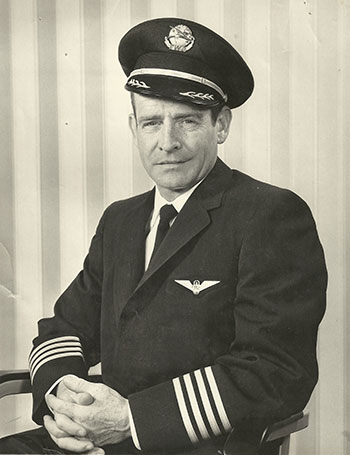 |
Given his experience in flight-testing, acceptance testing, and pilot training, Max was promoted to superintendent of flight training at TWA on June 1, 1952. In that role, he was responsible for the successful transitioning of pilots into the growing fleet of airplanes, including the ultimate Connie variant, the L1649 Starliner, named “Jetstream” by TWA, below.
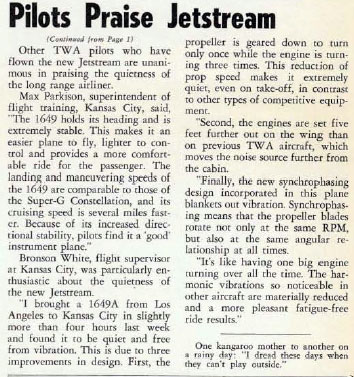 |
In 1956 Max assisted the embryonic German airline, Lufthansa by training their pilots and transitioning them to the airline’s own fleet of Lockheed Constellations. He was loaned to Lufthansa on a six-week training assignment. Perhaps the crowning achievement of his career was guiding the introduction of the Boeing 707 and Convair 880 jet transports into TWA’s fleet of piston-powered airplanes.
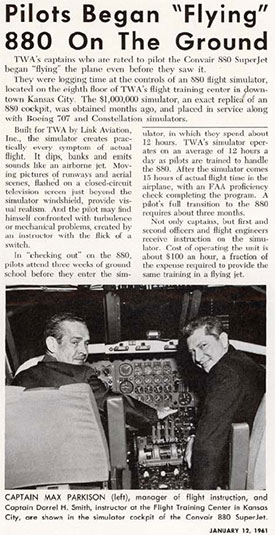 |
Max piloted some of the initial flights of the 707 as it set speed records on TWA routes as cited in the New Orleans Times-Picayune article dated June 8, 1959, below, and in the Chicago Daily Herald, July 16, 1959, following..
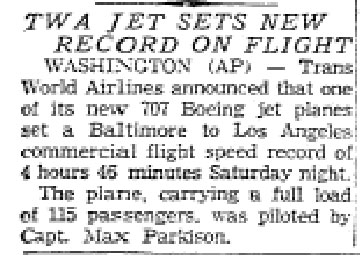 |
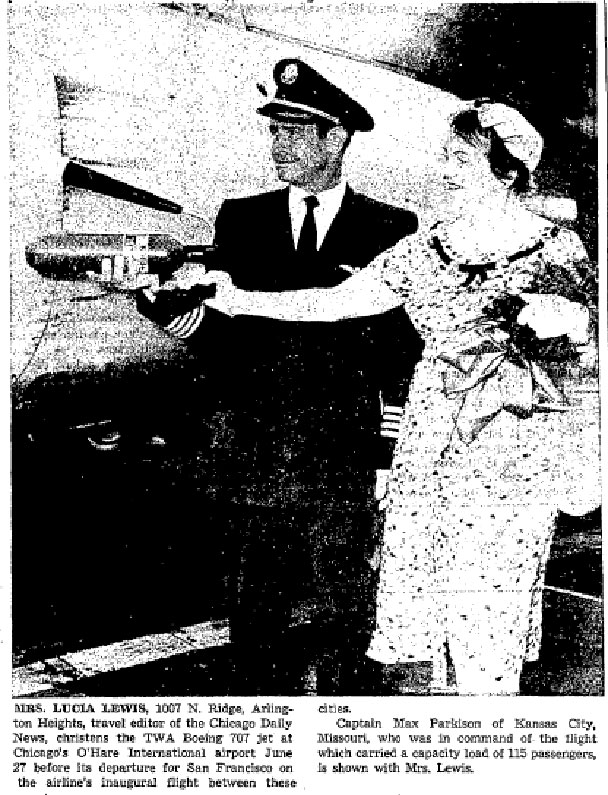 |
TWA’s successful transitioning of experienced propeller plane pilots into jet pilots was due in large part to the efforts of Max and other TWA training pilots.
Max took medical leave from TWA in 1966 and retired on August 1, 1968, having accumulated over 18,000 hours at the controls, either in a simulator or airplane. If you do the math, this represents flying over 1.5 hours every day for thirty-three years. Max flew West in May, 1983 from Kansas City. Special thanks to Max’s son John for providing the photos, logbooks and background information.
---o0o---
SPONSORED LINKS
THIS PAGE UPLOADED: 11/28/13 REVISED:
